Lesléa Newman is the author of 70 books for readers of all ages, including A Letter to Harvey Milk; October Mourning: A Song for Matthew Shepard; I Carry My Mother; The Boy Who Cried Fabulous; Ketzel, the Cat Who Composed; and Heather Has Two Mommies.
Here she talks about her children’s books, challenging gender stereotypes, championing diversity and the need to respect children’s intelligence…
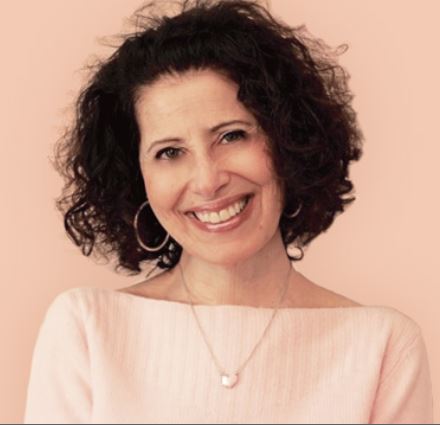
Your children’s books
What would you say the main themes in your children’s stories are?
Love, acceptance, respect, and celebration of all.
Heather has Two Mommies was first published in 1989 and has become an important part of children’s literature. How did people react to the book when it was first released? Have people’s feelings about it changed over time?
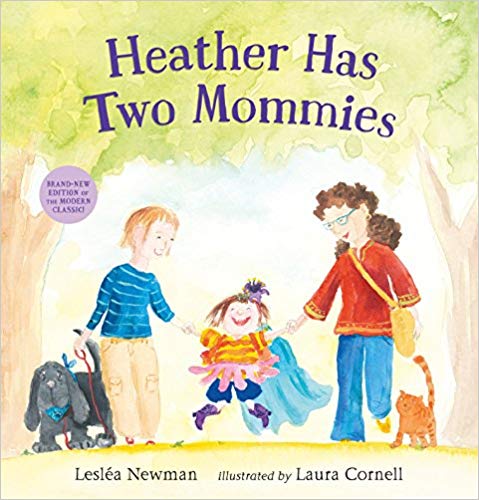
At first lesbian moms were thrilled to have a book that showed a family like theirs. That hasn’t changed. Of course some people were horrified by the book and did all kinds of things to stop it from reaching hands of readers (stealing it from libraries, lodging formal complaints, etc.). I’m happy to say that doesn’t seem to happen very often now.
In Sparkle Boy, Cassie is desperate to share his sister’s glittery nails and sparkling dresses, but his sister insists they are for girls and girls only. Campaigns like Let Toys be Toys are asking the toy and publishing industries to stop limiting children’s interests by promoting some toys and books as only suitable for girls, and others only for boys. What can teachers do to tackle these issues around gender inequality and gender stereotypes?
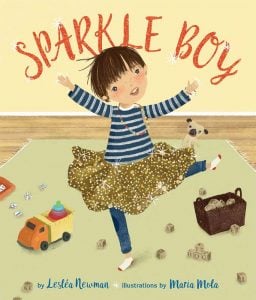
Teachers can present activities, toys, dress up clothes, and books without attaching gender to these items. Teachers can avoid gender-specific language and use gender neutral language. Teachers can support all the students in their classrooms to be themselves in every way.
You are a prolific writer and create books for adults, non-fiction, poetry, essays and books for teenagers. How is writing for younger children similar? How is it different?
To me, writing is writing, is writing. With children’s books, it’s important for the language and concepts one is writing about to be age appropriate. It’s also important to respect children and their intelligence and not write down to them.
Which of your children’s books is your favourite, or is that just too difficult a question to answer?
The one I haven’t written yet!
Apart from your own books, is there any other books or authors you would recommend to children that deal with similar themes?
- 10,000 Dresses by Marcus Ewert
- Morris Micklewhite and the Tangerine Dress by Christine Baldacchino
- Jacob’s New Dress by Sarah and Ian Hoffman
- Julián is a Mermaid by Jessica Love
- George by Alex Gino
This slideshow requires JavaScript.
What advice would you give to budding young writers?
Read as much as possible and write every day. Writing is like anything else such as being a musician or an athlete. The more you do it, the better you get at it.
October Mourning: A Song for Matthew Shepard
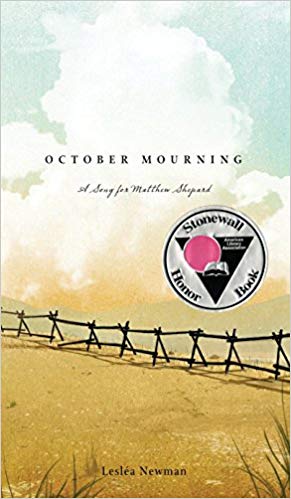
I have to talk to you about your beautiful collection of poems October Mourning: A Song for Matthew Shepard, which were written about the tragic events surrounding Matthew Shepard’s death. For those who don’t know, could you tell us a bit more about Matthew Shepard and your connection to him?
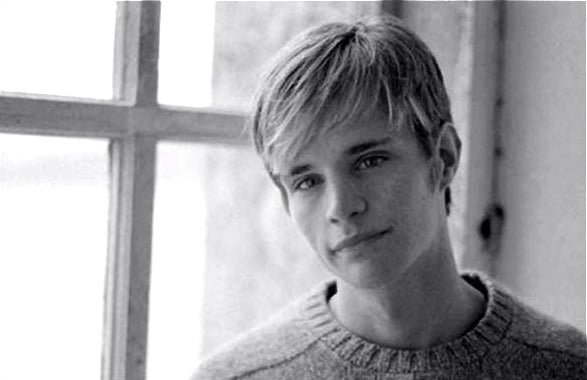
Matthew Shepard was an out gay college student at The University of Wyoming. In 1998, he was kidnapped from a bar, robbed, beaten, tied to a fence, and abandoned by two men who pretended to be gay and offered him a ride home. He was discovered unconscious 18 hours later and brought to a hospital. He died six days later at the start of the University of Wyoming’s Gay Awareness Week. I was the keynote speaker and arrived on campus the day that he died. My life was changed forever.
A few years ago, I got the chance to act in the play The Laramie Project written by the Tectonic Theatre Company about Matthew’s death and the impact it had on his loved ones and community. The experience was wonderful, but I also found it very tiring, difficult and emotional. I wondered if writing any parts of October Mourning very particularly difficult to write or research?
I wrote the book 10 years after Matt died. My main goal was getting the words right and doing the story justice. My emotions were irrelevant. I had a job to do. I have to say though, that the hardest poem, or the one that got to me most, and the one I never aloud read to an audience is “Where Is My Boy?” which is told in the voice of Matt’s cat who was at home alone the night of the attack. I am a big animal lover, and particularly a cat lover, and the thought of Matt’s cat Clayton waiting and waiting just tore my heart.
In the collection, the poems ‘Lame Excuse’ and ‘Heartfelt Apology’ draw upon William Carlos Williams’ poem ‘This is Just to Say’. What other poems, poets and authors influenced October Mourning?
Michael Lassell’s poem, “How To Watch Your Brother Die” has always haunted me and was the inspiration for “How To Have The Worst Day Of Your Life.” Wallace Stevens’ famous poem “Thirteen Ways of Looking at a Blackbird” inspired “Thirteen Ways of Looking at Matthew.” And pretty much every single poem I’ve ever read has influenced my writing in one way or another.
Why did you decide to use poetry and verse to remember and honour Matthew’s experiences? What does poetry allow you to do in this context?
There have been a lot of nonfiction articles and books about Matt’s murder; as a poet, I wanted to add something else to the conversation. Poetry is what I know best, and I hope gives readers an opportunity to look at the hate crime and its effect in a different way.
October Mourning is definitely sad and bitter-sweet, but it is also imbued with love, compassion and hope and this struck me because what happened was a terrible, shocking hate crime. The poems could just be filled with rage and anger, but they aren’t. Can you tell us a bit more about what you were trying to achieve?
As I said above, I was trying to do justice to the story. My aim was to give readers the opportunity to imagine really being in Wyoming that night, which is why I wanted to paint as full as picture as possible from all different points of view. And then hopefully, readers will be inspired to do something in Matt’s name to make the world a safer, more humane place for everyone.
I love the idea of telling Matthew’s story from the perspective of the ‘silent witnesses’ (the fence, the road, the stars, the dear, the clothes line) and the idea that they become an extension of Matthew. Can you tell us more about this decision?
It wasn’t a conscious decision so much as something that came to me—one of those aha! moments that we poets dream of. I kept coming back to the central question of “What actually happened that night?” Matt can’t tell us, obviously, and I don’t trust that his two killers have told the whole truth of what occurred (and in fact, in some ways their stories contradict each other). If only there were witnesses, I said to myself. And then I had the realization that there were witnesses, such as the fence, the moon, the stars, etc. And I started writing in their voices to see what they had to say.
In ‘The Drag Queen’, ‘The Cop’ and ‘The Student’ you explore both the positive and negative changes that have occurred since Matthew’s death. Do you think people’s views about the LGBT+ community have changed since then? If so, how? What else needs to be done to ensure nothing like this happens again?
I think that in the 20 years since Matt was murdered, things have changed a lot. But it also seems that there are always individuals who are threatened by people’s sexuality and gender expression and sometimes respond in violent ways. We just have to keep going what we are doing (the folks at the Matthew Shepard Foundation, including Matt’s parents, Judy and Dennis) work tirelessly to spread the message of love, compassion, and understanding. We all need to do the same every single day.
In ‘Then and Now’, you talk about Matthew being a symbol and lesson. What do you think Matthew’s legacy has been?
His legacy lives on in the Foundation that bears his name and all the good work that thousands of people have done in his memory to make the world a better place.
Your career
What challenges did you face when you first started writing? How did you stay resilient?
I have been very lucky since the beginning. I had wonderful teachers including Allen Ginsberg and Grace Paley who encouraged me and supported me. I never wanted to be anything but a writer, so when things aren’t going well, I know it is up to me to change that. A writer has to have very thick skin and above all else, keep writing.
Do you remember any pieces of advice you’ve received during your career that you could share with us?
Read as much as possible, write every day, never cohabitate with a manuscript (in other words, send your work out, don’t let it languish in a drawer).
How does your intersectionality impact and influence your writing?
Being a Jew, being a lesbian, being a woman of a certain age impacts everything I do. These are the lenses through which I see the world and of course that influences my writing.
This slideshow requires JavaScript.
People often talk about reading for pleasure, but as a young gay man I often remember trying to seek out books that reflected and mirrored my own experiences. What might we call this? Reading for empowerment possibly? Do you consider reading to be a political act as well as a pleasurable act?
Reading is definitely a political act, as is writing, as is every single choice we make every single day.
I was saddened to read that there has been ‘a spate of attempts around the world to remove titles depicting gay or transgender characters from library shelves’ (The Guardian, January 2019). Why do you think children’s books that explore the lives of gay and transgender characters are still so important?
Children need “windows and mirrors” as Dr. Rudine Sims Bishop so famously said. They need to see themselves reflected in the literature they read (mirrors) in order to feel validated and they need to see others depicted in literature (windows) in order to develop respect, acceptance, and celebration of people who are not like them.
In terms of children’s literature, what do you hope your professional legacy will be?
I hope my legacy will be that I tried to make the world a better place by writing books for children with all sorts of identities from all sorts of families, and that above all else, I was kind to other writers.

